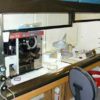Every pathology department and associated histology laboratory must have a chemical monitoring program. It may be part of a larger Chemical Hygiene Plan. Laboratory employees must be kept safe by providing information on dangers, explaining the ways in which employees can protect themselves, and providing annual training to reinforce this information. This is not just a good plan – in most instances, this plan is backed by laws and regulations. This current blog will continue the ideas of the previous one, where we discussed engineering controls such as grossing hoods used in laboratories to provide safe work stations.
OSHA – The Formaldehyde Standard
OSHA uses different types of limits for airborne exposures, which reflect Permissible Exposure Limits (PEL).
Time Weighted Average (TWA) is the airborne concentration averaged over eight consecutive hours. The TWA for formaldehyde is 0.75 ppm. No employee may be exposed to more than 0.75 ppm of formaldehyde over eight hours.
Short Term Exposure Limit (STEL) is the airborne concentration averaged over the worst 15 minutes. The STEL for formaldehyde is 2 ppm.
OSHA has also set an Action Level for formaldehyde of 0.5 ppm averaged over 8 hours. If this limit is reached or exceeded, the employee must be notified and steps taken immediately to adjust procedures that result in a decrease of the airborne concentration.
Employee monitoring is required to document the exposures existing in the laboratory. Initial monitoring of each exposed employee is required, unless monitoring has been done previously for a particular job description. Monitoring must be repeated if there is a change in work procedures or control systems since initial monitoring. If an employee displays any exposure symptoms (i.e. respiratory, dermal, etc.) the employee must be monitored immediately.
If either the TWA or STEL is exceeded, the employer can:
- Install engineering controls, such as increased ventilation and/or use specially designed filters for the laboratory air.
- Change work practice controls, such as procedural changes.
- Provide and require use of respirators.
Periodic employee monitoring depends on the initial monitoring results.
- If exposure levels are at or above the Action Level of 0.5 ppm, immediate monitoring must be done for each employee or job description and continued until the issue is resolved.
- If the STEL is exceeded, immediate monitoring must occur and continue until the issue is resolved.
Periodic monitoring may be discontinued if two successive samples taken at least seven days apart are below the Action Level and STEL.
Recommendation: Even if your laboratory monitoring results are satisfactory, and you are not required to perform any additional monitoring, it is recommended that you continue annual chemical monitoring for laboratory employees. This benefits both the employer and the laboratory employees by demonstrating the commitment to a safe work environment. If your laboratory is larger than eight employees, you can select two employees from each job classification (i.e. accessioning, grossing, lab aide, histotechnician) to be monitored. The results are valid for every employee in each job classification, as the tasks are the same for each. For laboratories that have less than eight employees, it is recommended that every employee participate in the chemical monitoring process.
Required: Safety goggles, gloves and an impervious gown, as well as access to an eyewash station and safety shower are required when handling formalin, regardless of the exposure limit.
Remember:

The above label must be present on EVERY container and specimen bottle of formaldehyde. It is there for a reason. Formaldehyde is a POISON and CARCINOGEN. You must handle it with proper personal protective equipment (PPE) using a ventilated work station…always…without exception.
Histology laboratory personnel who change out tissue processors, and who perform the surgical grossing of specimens, are especially prone to formaldehyde liquid and vapor exposure. Personnel must wear the PPE described above while handling formaldehyde. Additionally, when pouring containers of formaldehyde (i.e. from on board tissue processors, into waste containers), employees should be performing this function in a fume hood to prevent exposure. Alternatively, employees may be fit-tested for a respirator to wear during the handling of formaldehyde. Goggles, rather than safety glasses, are the eye protection of choice, since they protect against splashes and vapors.
REFERENCES:
- Theory and Practice of Histological Techniques. JD Bancroft, A Stevens ed. Churchill Livingstone, NY. Fourth edition. 1996
- Theory and Practice of Histotechnology. DC Sheehan, BB Hrapchak. CV Mosby Company, St. Louis. First edition. 1980.
- Dermatopathology Laboratory Techniques. CM Chapman, I Dimenstein. 2016. Amazon.com
- Dapson and Dapson. Hazardous Materials in the Histopathology Laboratory. Anatech Ltd.


